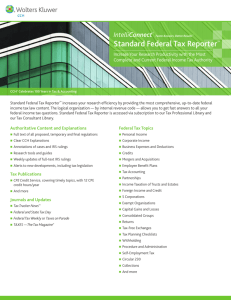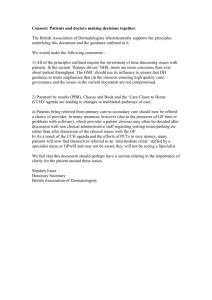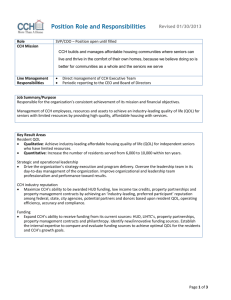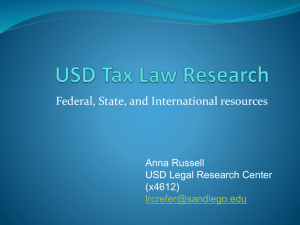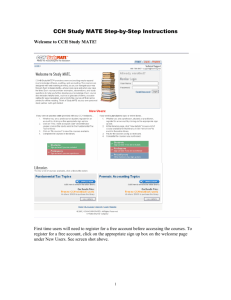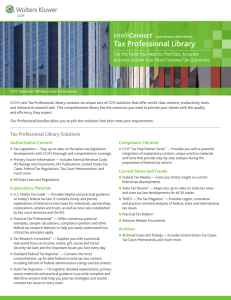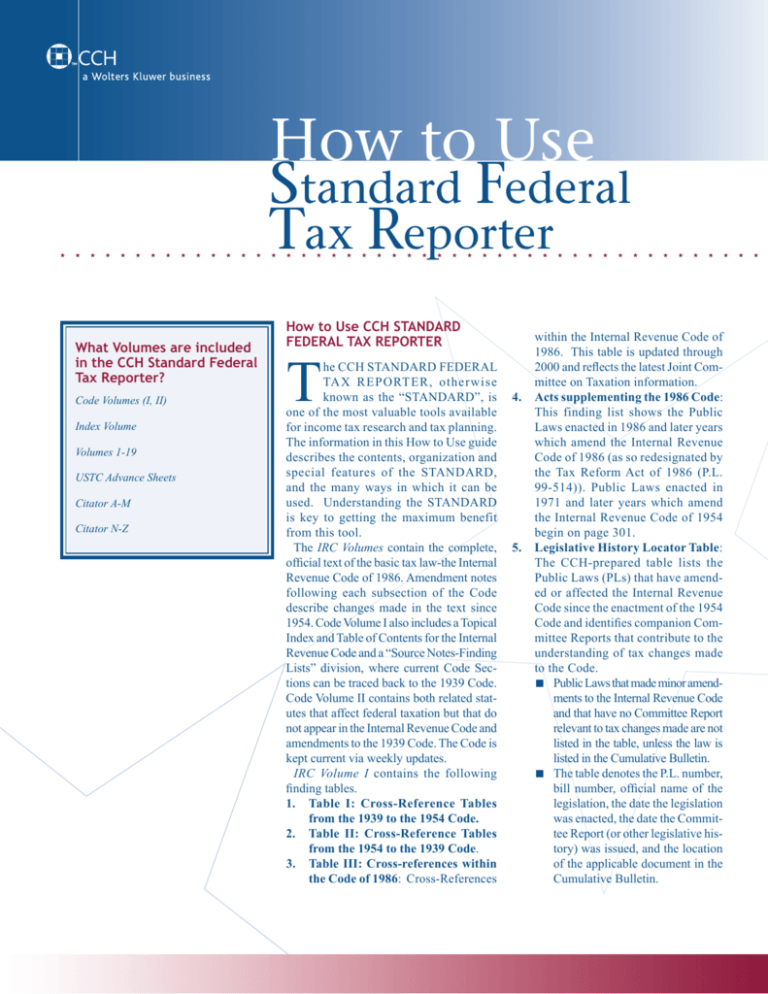
How to Use
Standard Federal
Tax Reporter
What Volumes are included
in the CCH Standard Federal
Tax Reporter?
Code Volumes (I, II)
Index Volume
Volumes 1-19
USTC Advance Sheets
Citator A-M
Citator N-Z
How to Use CCH STANDARD
FEDERAL TAX REPORTER
T
he CCH STANDARD FEDERAL
TAX REPORTER, otherwise
known as the “STANDARD”, is
one of the most valuable tools available
for income tax research and tax planning.
The information in this How to Use guide
describes the contents, organization and
special features of the STANDARD,
and the many ways in which it can be
used. Understanding the STANDARD
is key to getting the maximum benefit
from this tool.
The IRC Volumes contain the complete,
official text of the basic tax law-the Internal
Revenue Code of 1986. Amendment notes
following each subsection of the Code
describe changes made in the text since
1954. Code Volume I also includes a Topical
Index and Table of Contents for the Internal
Revenue Code and a “Source Notes-Finding
Lists” division, where current Code Sections can be traced back to the 1939 Code.
Code Volume II contains both related statutes that affect federal taxation but that do
not appear in the Internal Revenue Code and
amendments to the 1939 Code. The Code is
kept current via weekly updates.
IRC Volume I contains the following
finding tables.
1. Table I: Cross-Reference Tables
from the 1939 to the 1954 Code.
2. Table II: Cross-Reference Tables
from the 1954 to the 1939 Code.
3. Table III: Cross-references within
the Code of 1986: Cross-References
4.
5.
within the Internal Revenue Code of
1986. This table is updated through
2000 and reflects the latest Joint Committee on Taxation information.
Acts supplementing the 1986 Code:
This finding list shows the Public
Laws enacted in 1986 and later years
which amend the Internal Revenue
Code of 1986 (as so redesignated by
the Tax Reform Act of 1986 (P.L.
99-514)). Public Laws enacted in
1971 and later years which amend
the Internal Revenue Code of 1954
begin on page 301.
Legislative History Locator Table:
The CCH-prepared table lists the
Public Laws (PLs) that have amended or affected the Internal Revenue
Code since the enactment of the 1954
Code and identifies companion Committee Reports that contribute to the
understanding of tax changes made
to the Code.
Public Laws that made minor amendments to the Internal Revenue Code
and that have no Committee Report
relevant to tax changes made are not
listed in the table, unless the law is
listed in the Cumulative Bulletin.
The table denotes the P.L. number,
bill number, official name of the
legislation, the date the legislation
was enacted, the date the Committee Report (or other legislative history) was issued, and the location
of the applicable document in the
Cumulative Bulletin.
2
How to Use Standard Federal Tax Reporter
Where legislation does not carry
an official name, a description of
the contents of the legislation is
provided. Bill numbers for Committee Reports that differ from the
bill number of the enacted legislation are noted.
6. Public Laws Amending the Internal
Revenue Code
The Index Volume contains the main Topical Index to the STANDARD, a listing of
over 80,000 subject and key word entries
that pinpoint the location of the desired information in the Compilation volumes. Tax
calendars, tax tables and an inflation adjustment guide, other special tables, checklists,
a glossary of tax terms and tax planning
sections are located in the Index Volume.
Volumes 1-18 contain over 40,000 pages
detailing the legislative, administrative
and judicial aspects of income tax law.
The Compilation volumes are arranged by
Code sections for effective tax research.
Major income tax subjects, Code sections
and paragraph designations appear on the
spine of each volume. Inside, each income
tax section of the Internal Revenue Code
is coordinated with pertinent legislative
Committee Reports, Regulations, “CCH
Explanations,” and summaries of court
decisions and rulings from 1913 forward. In
addition, Volume 1 includes the following
special sections: “Who is the Taxpayer,”
“Income Tax Return Preparers,” and “Tax
Protesters.” Volume 17 contains the Tax
Court Rules of Practice and the Federal
Rules of Appellate Procedure. Volume 18
covers IRS Organization, practice and procedure and includes the IRS Statement of
Procedural Rules and Circular 230. Internal
Revenue forms, publications and personnel
are listed in Volume 18. The Code, Explanation and Regulations are kept current via
weekly updates.
Volume 19 contains Treasury Decision
preambles, hearing notices, legislative
status tables, summaries of Tax Court decisions, full text of IRS rulings and other
releases, and the Supreme Court Docket.
CCH Comments, Tax Focuses and other
analytical articles are also featured. This
volume also includes the indexes, case
tables and finding lists for new matters,
including those in the U.S. Tax Cases-Advance Sheets Volume.
The USTC Volume contains the full texts
of new income tax decisions from the
federal courts, including the U.S. Supreme Court, the U.S. Courts of Appeals,
the U.S. District Courts and the U.S.
Court of Federal Claims. Summaries of
the court decisions reported at the end
of the previous year also appear in the
USTC Volume. Included in this volume
as well are the Notices of Proposed Rulemaking relating to proposed amendments
to the regulations.
The two Citator Volumes, A-M and
N-Z, are used to locate cases and rulings in the Compilation volumes. The
Citator Table lists the federal income tax
decisions that have been handed down
since 1913, together with references to
the paragraphs where the cases are summarized or cited in Volumes 1-18. The
judicial history of each case is given, as
well as a record of citations listing later
decisions in which it has been discussed.
In addition to the cases reported. Volume
N-Z also contains the Finding Lists for
locating Revenue Rulings, Revenue
Procedures and other IRS and Treasury
Department releases. A list of Committee
Reports that clarify the Congressional
intent behind amendments to the Internal
Revenue Code is also included in Citator
Volume N-Z.
Weekly Reports
A weekly report provides new developments in income tax law and updates information in the STANDARD. Each Report
consists of two or more parts. “Taxes on
Parade” summarizes the tax news of the
week. It covers not only all new developments contained in the weekly report, but
also other tax news of current interest. Part
II of the Report consists of new pages ready
for insertion in the loose-leaf volumes. Periodically, the Reports include a CCH Tax
Focus, a four-page analysis of a current tax
topic or issue.
Special Publications
Special publications on income tax matters
are periodically included with the weekly
reports. Legislative specials include the full
official text of major tax bills and explanatory Committee Reports. Customers also
receive the CCH Explanation and Analysis
of major tax legislation that is passed by
Congress. The filled-in forms publications contain reproductions of individual
income tax, corporate income tax, estate
and trust tax and partnership return forms,
filled in for hypothetical taxpayers and accompanied by valuable explanations. Other
booklets provide additional information on
subjects of current interest.
U.S. Master Tax Guide
The U.S. MASTER TAX GUIDE is an
accurate, up-to-date manual of the current
income tax rules. The GUIDE features tax
rate schedules and tables, tax calendars,
and checklists indicating whether items
are taxable, nontaxable or deductible. The
GUIDE assists in the preparation of returns
and also serves as a reference tool for more
detailed tax research via footnotes and other
references to the STANDARD.
Federal Tax Sources 1986
Internal Revenue Code
The two Internal Revenue Code Volumes
that accompany the current edition of the
STANDARD reproduce the 1986 Code as
amended to date
Committee Reports
Subscribers to the STANDARD receive the
full texts of Congressional Committee Reports on major tax legislation by means of
“extras” that are issued as the bill is pending in Congress. After a tax bill becomes
law, significant portions of the controlling
Committee Reports are reflected in the
STANDARD, following the Code sections
to which they relate.
Regulations
In the STANDARD, the full text of all
proposed, temporary and final Regulations
follow the applicable Code sections that they
interpret. A list of proposed Regulations,
along with the notices of proposed rulemaking, appears in the U.S. Tax Cases Volume. A
Regulation Table listing Regulations issued
by the IRS under the 1986 Code and the text
of recent Treasury Decisions that adopt and
amend Regulations appear in Volume 19.
Federal Court Decisions
All new regular and memorandum
Tax Court decisions are reported and
3
summarized weekly in Volume 19 of
the STANDARD. IRS acquiescence/
nonacquiescence action is announced
in the Internal Revenue Bulletins and
reflected in the STANDARD in the
Current Case Table and the Cumulative
Index in Volume 19.
Full texts of current federal income tax
decisions issued by the U.S. District
Courts, the U.S. Courts of Appeals,
the U.S. Court of Federal Claims and
the U.S. Supreme Court are reported in
the U.S. Tax Cases - Advance Sheets
Volume of the STANDARD with each
new edition of the STANDARD.
Court decisions from the prior year are
reflected in place in the Compilation
volumes in each new edition of the
STANDARD. These annotated cases
are arranged by topic following the applicable Code section and Regulations.
Along with Revenue Rulings and Revenue
Procedures, IRS Notices, Announcements
and New Releases are reproduced in full
text in Volume 19 of the STANDARD as
they are issued. Like the cases, annotated
rulings and other IRS and Treasury Department releases are incorporated into
the Compilation volumes with each new
edition of the STANDARD.
references in the index system, finding lists
and the Citator provide the exact location
of information. Guide cards group the
contents of each volume to facilitate speedy
reference to a particular point.
Spine-The spine of each volume of the
STANDARD clearly lists the main topics or other materials contained in the
volume, along with the Code sections
and paragraph numbers included, allowing you to find the appropriate volume
at a glance.
Topical Index-The Index Volume
contains a detailed alphabetical subject
matter index to the entire set.
Table of Contents-The Table of Contents for the entire set, listing the topics
covered in each volume, is located at the
beginning of each volume. Each division
in the STANDARD begins with a Table
of Contents that lists Code sections,
Regulations and CCH Explanation paragraphs included in that division.
Overviews-Each division begins
with a preliminary discussion of the
subjects covered to help you narrow
your search.
Citator and Finding Tables-The
two Citator Volumes provide access
to information through case tables
and finding lists for IRS and Treasury
Department releases.
Getting Into the Text
Special Features of the Text
Due to continual restructuring by Congress and frequent interpretations by the
IRS and the Courts, the federal tax system
grows more complex with each passing
year. The STANDARD helps the user
resolve problems, both large and small,
that arise from the complexity of the tax
law. Throughout the volumes, comments,
explanations, examples and editorial discussion combine with the official statutes,
Regulations and authorities to assist in the
solution of tax questions.
CCH understands that tax professionals
need options to help them find relevant
information quickly and easily. Therefore,
the STANDARD offers a variety of excellent finding-tools for rapidly pinpointing
specific information: the binder spine, the
index volume, the table of contents at the
beginning of each volume, the Overviews,
and the Citator and finding lists. Paragraph
The individual “Compilations”-coordination of Code sections, Regulations,
CCH Explanations and summaries of
court decisions and IRS rulings-utilize
a distinctive typography and format for
each component.
IRS Releases
Standard Federal Uniform
Paragraph Numbering
No Decimal Points
Code
Regulations
Decimal Points
Committee Reports
Explanations
Annotations
FED Explanation Numbering
.001
.002
Legislative Developments
Significant Developments
©2006, CCH. ALL RIGHTS RESERVED.
.01
.02
.021—.0599
Synopses
Taxpayers Affected
[Reserved for General
Explanations]
.06
Effective Dates
.062
Transition Issues
.066
Exceptions
.068
Penalties
.07
Key Rates & Figures
.073
Elections
.075
Reporting Requirements
.08
Proposed Regulations
.09
Related Code Sections
.095
Other sources.
Each Code section is reproduced in full
and flagged in the left margin. “Historical
Notes” indicate whether there have been
any amendments since 1954 and cite the
location of other pertinent information,
such as Committee Reports. Code sections
are always kept up-to-date. Amendments
and changes are published promptly, and
new pages are included in current Reports
for insertion in the Compilations.
Regulations are always introduced by a
catch-line identifying the type of Regulation-final, temporary, or proposed. The
Regulations are printed in larger type
across the full width of the page. Proposed
Regulations, and proposed amendments to
existing Regulations, are reported in place
following the applicable Code section
that they are intended to implement. Their
unique presentation within boxes alerts
readers to their status as proposals and to
their relationship to existing Regulations.
Paragraph references to the Notice of Proposed Rulemaking in the USTC volume are
also provided.
If the IRS has not updated a Regulation
to reflect changes brought about by recent
legislation, CCH alerts you to the fact with a
caution note. Caution notes are also used elsewhere in the STANDARD to flag the effective
date of new legislation and to point out other
special circumstances concerning a particular
Code section, Regulation or annotation.
Controlling Committee Reports are reproduced following the text of the Code
Section. Committee Reports are printed in
double column format.
CCH Explanations are set in larger type.
They have their own catch-line and are
enclosed within boxes to distinguish them
from official contents. CCH Explanations
4
How to Use Standard Federal Tax Reporter
provide interpretation and analysis of
the law and point out trends or conflicts
among authorities.
Examples contained in the CCH Explanations use actual calculations to show
how a Code section applies to a specific
problem, giving concrete illustrations of
likely tax consequences.
Summaries of decisions and rulings,
called “annotations,” follow the Code
section and Regulations construed. A table
indexing the annotations precedes each
large group of annotations. Annotations
are arranged in double column format.
The case name or ruling number, as well
as the citation to the full text, is noted
under each annotation.
Any authoritative source is only as up-todate as the latest revision of its contents.
The CCH system of rapid and efficient
current reporting informs you immediately
of new and pending matters. New pages
are dispatched weekly to replace or add to
existing pages in the loose-leaf volumes.
Thus, the STANDARD always contains the
latest information on income tax matters.
Subscribers are alerted to significant New
Developments and recent tax legislation
at the beginning of each explanation. Tax
law changes are highlighted in the first
paragraph or paragraphs of the relevant
explanation with the use of a .001 Tax
Legislation sidehead that describes the
change and gives the popular name of the
law. For example:
.001 Tax legislation—dependent
care credit.-Gulf Opportunity
Zone Act of 2005.
The explanation provides a summary of the
tax law change and refers the subscriber to
the explanation paragraph where the change
is described in more detail.
Similarly, significant developments are
indicated with the use of .002 Significant
developments side head. For example:
.002 Significant developmentsfinal regulations released on the
education credits.
The explanation provides a summary
of the development and refers the subscriber to the explanation paragraph
where the development is described in
more detail.
“CCH Comments” in Volume 19 discuss
significant rulings and decisions interpreting
the law and Regulations, with special emphasis on problems not yet definitely settled
by the courts. These concise analytical
articles probe the tax meaning of the cases,
point out their ramifications and indicate the
probable effect on other controversies.
“CCH Tax Focus and Features,” another
exclusive and practical feature of the STANDARD, analyze current tax problems and
demonstrate their effective solution. They
may also spotlight diverse Code and Regulation provisions bearing on one particular
subject. Questions upon which the courts do
not agree are frequently analyzed.
Researching with the STANDARD
The STANDARD is designed to give you
several options for tax problem solving. Its
Code section organization and multiple information finding tools make even the most
detailed research logical and easy.
There are 3 basic approaches for finding
what you need in the CCH STANDARD
FEDERAL TAX REPORTER:
Approach by Number
Approach by Subject
Approach by Case Name
ments corresponding to the issue that
you are researching.
The second volume of the Citator
includes finding lists of IRS and Treasury Department releases. You may
use the finding lists to locate specific
information when you already know
the number of a relevant IRS ruling
or procedure. These lists provide
paragraph references to where each
item is discussed or annotated in the
main volumes.
You know that Rev. Rul. 90-61, relating to the loss of tree seedlings to a
severe drought, will answer one of
your questions about casualty losses.
The Finding List in Citator Volume
N-Z provides several paragraph references where this ruling is annotated,
including ¶10,005.71.
The Finding List will also describe
further action relating to the ruling,
such as whether it has been modified,
amplified, superseded or revoked.
Always check the Current Finding
Lists in Citator Volume N-Z and the
Finding List of RuIings in Volume
19 for the latest information on rulings and other releases.
Approach by Number
Approach by Subject
The STANDARD is “Code-organized”
throughout; thus, the Internal Revenue Code
Sections appear in numerical order. Code
sections, topics and paragraph numbers appear on the spines of the binders so you can
quickly select the volume that discusses the
issue you are researching. The tab guide for
each division indicates the topics, first Code
section, and beginning paragraph number
included in that division.
For example, you have a question about
casualty losses, which you know are governed by Code Sec. 165.
To find Code Sec. 165, first look at the
spines of the binders. This Code section is
located in Volume 4:
Go to the tab guide in Volume 4 that
lists “Deductions: Losses.” This division begins at ¶9801. Code Sec. 165 is
found at ¶9802, the relevant Regulation
appears at ¶10,004, and the CCH Explanation on casualty losses is at ¶10,005.
Always check the Cumulative Index
in Volume 19 to find recent develop-
The main subject indexes for the STANDARD are located in the Index Volume.
Use the detailed alphabetical Topical Index
to pinpoint the location of precise rules
on point.
You can research the issue of casualty
losses relating to timber in the following manner.
Go to the Topical Index in the Index
Volume; see “Casualty losses,” The
one and two-dot entries pinpoint the
exact location of information on the issue you are researching, You will find a
one-dot entry for “timber” directing you
to ¶10,005.71-->¶10,000.76.
After you read the material at ¶10,005,
go to Volume 19 and check the Topical
Index to New Developments and the
Latest Additions to the Topical Index for
entries under “Casualty losses” for the
latest developments in the area.
The tables of contents can also be used to
quickly locate information when you know
the general topic. A list of Code sections
5
and a table of contents for the entire set,
listing the topics covered in each volume,
are located at the beginning of each volume. Each division also contains a table of
contents listing each Code section, Regulation and CCH Explanation paragraph that
appears in that division. An Overview that
summarizes the contents of each division
follows the table of contents and provides
further guidance.
In researching the issue of the deductibility of disaster losses, you can use the three
levels of the tables of contents to locate the
desired information.
Go to the main Table of Contents
found at the front of each volume.
Scanning the list of topics, you will
find that “Deductions: Losses” are
discussed in Volume 4, in the division beginning with Code Sec. 165
at ¶9801.
Go to Volume 4 and turn to the Table
of Contents for the division beginning
at ¶9801.
You find that the text of Code Sec. 165,
dealing with deductible losses, is at
¶9802. The Regulation and the CCH
Explanation that discuss disaster losses
are located at ¶10,200 and ¶10,201.
Turn to the Overview following the
Table of Contents for further information on the topic of disaster losses.
Check the Cumulative Index to see
if there are any new developments
relating to the relevant Explanation
sections. The entries will highlight
any pertinent new cases, rulings or
regulations.
Approach by Case Name
Each Citator Volume includes a table of
cases, arranged in alphabetical order. You
may use the Citator table to locate specific
information when you already know the
name of a relevant case. These lists provide
paragraph references to the place where
each item is discussed or annotated in the
Compilations.
Suppose you want to find decisions that
discuss the Supreme Court’s decision in
R.P. Groetzinger, relating to the deduction
of losses by full-time gamblers.
The Groetzinger case is located in Citator Volume A-M. Following the case
name, you will find the paragraphs
where the annotation of the case appears. A list of other decisions that
discuss the case follows.
When using the Citator, also, check the
Current Citator Table at the beginning
of Citator Volume A-M and the Current
Case Table in Volume 19 for further
action on the case.
Check the Cumulative Index to see if
there are any new developments relating to the relevant CCH Explanation
or annotation paragraph. The entries
will highlight any pertinent new cases,
rulings or regulations.
Items contained in “Taxes on Parade,”
the weekly report letter, are digested or
reproduced in full text in Volume 19 or in
the U.S. Tax Cases volume of the STANDARD. The headnotes for the cases or
rulings that appear in these new volumes
include back references to the relevant explanation or annotation paragraphs.
For example, a “Taxes on Parade” story
summarizes the loss issues in the J. Green
case ¶49,693(M). The decision discusses a
loss deduction that was disallowed for an
uncollectible judgment.
As noted at the end of the “Taxes on
Parade” story, the headnote for the
decision appears at ¶47,693(M) in
Volume 19 of the STANDARD. You
will find back references to the appropriate annotation paragraphs for
the Code Sec. 165 issues at the end of
the headnote.
Practice Aids
The STANDARD offers a variety of special
practice aids.
Checklists-A quick check on common
deductions (including medical expense
deductions) and income items can be
made by using the checklists in the
Index Volume. The various items are
listed by type, with references to the
relevant Code sections and CCH Explanations for full details. Other checklists
cover Form 1040, Form 1120, State real
property taxes, tax elections, information returns and disaster areas.
Tax Calendar-The Tax Calendar in the
Index Volume indicates the final dates
for filing various returns and meeting
other requirements imposed by the
Code and Regulations.
©2006, CCH. ALL RIGHTS RESERVED.
Tax Rates-Another special division in
the Index Volume includes the income
tax rates for each year, all the way back
to 1913. Current estate, gift and excise
tax rates are also listed.
Tax Terms-Commonly used tax terms
are defined in the “Tax Terms-Quick
Answers” division of the Index Volume, with references to the main volumes for further information.
Administration and ProcedureAdministrative and procedural
questions are covered in Volume
17 and Volume 18. Included are
Code provisions, Regulations, CCH
Explanations and annotations. Special features include lists of IRS
personnel, Tax Court Rules and
the procedure for appealing to the
Courts of Appeals.
Tax Treaties-The “Tax Treaties” division in Volume 11 reproduces the full
text of the Canadian tax treaty and
provides summaries of other tax conventions. A treaty developments status
table and annotated cases and rulings
are also included.
Withholding Tables-Current income
tax withholding tables for the various payroll periods, as well as a table
showing the percentage method of
withholding, are reproduced in the
Index Volume.
Special Tables-the following special
tables are included in the Index Volume: Depreciation Tables, Annuity
Tables, U.S. Savings Bond Tables,
Interest Rate Tables, Low-Income
Housing Credit Tables and the Per
Diem Rate Tables.
Tax Planning-Major tax factors to
be considered in tax planning are
discussed in separate divisions in
Volume 1. In addition, the inflation
adjustment guide provides a handy
reference to items affected by inflation adjustments.
Supreme Court Actions-You can
locate U.S. Supreme Court actions
in three different ways in the STANDARD. The Supreme Court Docket
in Volume 19 lists pending appeals
by name and shows where each case
stands currently. The Current Case
Table in the same volume also lists
6
How to Use Standard Federal Tax Reporter
Supreme Court actions. Finally, the
Cumulative Index in Volume 19
notes applications for certiorari, actions on petitions for certiorari, and
Supreme Court holdings.
Forms and Publications Lists-The
more important IRS forms are listed
both numerically and alphabetically by
subject in Volume 18. The numerical
listing includes a description of the
form, its purpose and the date of the
last revision. Also appearing in Volume
18 is a numerical listing of the more
commonly used IRS publications. The
publication number and title are indicated along with a brief description of
the subject matter.
How to Cite This Reporter
The STANDARD is cited by year or
edition (e.g., 2006) and volume number.
These numbers are combined with the
letters “CCH” and the paragraph number
referenced. Thus, “2006(7) CCH ¶18,951”
refers to the 2006 edition, Volume 7,
¶18,951. A reference to “964 CCH ¶2620”
directs you to Volume 4 of the 1996 edition, ¶2620.
An Income Tax Problem to Solve
Researching an actual problem is the best
way to demonstrate how the STANDARD
can be used. The pages illustrating the
coverage of the following problem appeared in a recent edition of the STANDARD, but the methods of research
described here would apply equally to
any edition. See the end of the problem
for excerpts from the STANDARD that
are used to solve the problem.
Your clients Mr. and Mrs. Black
paid their grandson’s first-semester
tuition. They have heard that there is
something called the Hope scholarship
credit and wonder if they can claim the
credit on their income tax return. Their
grandson is claimed as a dependent on
his parent’s income tax return.
Approach by Subject
The main subject area in this problem is
education credits. You can use the main
Topical Index in the Index Volume to begin
your research.
Using the main Topical Index, find the
main heading “CREDITS AGAINST TAX”
and the entry for Hope scholarship credit.
This leads to ¶3830.01-¶3830.075. There
is a further subheading for “third- party
payments” leading to ¶3830.041.
Note how the index is structured. The main
heading, “CREDITS AGAINST TAX,” is
in capital letters and large, boldface type.
The subheadings, such as “Hope scholarship credit,” are indented and preceded by
a single dot. More specific entries, such
as “third-party payments,” are further
distinguished by two dots.
You can see how easily the main Topical
Index pinpoints the material you need. It
provides the appropriate references that
show which paragraphs in the main volumes pertain to your question.
Selecting the Correct Volume
Selecting the correct volume is simple. The
paragraph numbers printed on the spines
of each binder indicate the range of paragraphs covered in each volume. You can
see that ¶3830 appears in Volume 1, which
includes paragraphs ranging from ¶621 to
¶5500. You can turn directly to the correct
division in this volume by noting the beginning paragraph number on each tab guide.
The paragraphs that you have located are
in the division beginning with ¶3501. “Tax
Credits” appears on the tab guide.
Following the tab guide, you will find the
division Table of Contents. You will note
that ¶3820 is the reference for Code Sec.
25A, and that the related CCH Explanation
appears at ¶3830. There are also regulations
on the education credits at ¶3821--¶3828.
The full text of Code Sec. 25A is
reproduced at ¶3820 in Volume 1. Immediately following the Code section
is a listing of the various laws that have
amended the section. By reading the text
of Code Sec 25A, we find the rules that
apply to the Hope scholarship credit,
but the answer to the Blacks’ question
is not obvious.
You will have to look further to find
the information on third-party payments. You can turn to the CCH Explanation and annotations paragraphs that
you found in the main Topical Index for
more information.
CCH Explanations
The CCH Explanation summarizes the
subject. At ¶3830.041, you learn that
qualified tuition and related expenses
paid by a third party are treated as if
paid by the student. The explanation
cites Reg. §1.25A-5(b). The Cumulative Index also directs you to a CCH
Code Section which is found at ¶3828.
Another entry listed in the Topical Index,
“dependent payments” at ¶3830.043
will now be of interest. This explanation, citing Code Sec. 25A and Reg. §
1.25A-5(a) states that expenses paid by
a “dependent are treated as paid by the
taxpayer if the student is claimed as a
dependent of the taxpayer.
Annotations by Topic
The Topical Index also directs you to
summaries of cases and rulings, called
“Annotations.” Another aid for annotated cases and rulings is the “Annotations by Topic” table that follows the
CCH Explanations.
You can now turn to the annotations to
help solve the problem. The annotation
at ¶3830.20 “Guidance” is the full text
of Notice 97-60. This Notice discusses
various aspects of the Hope scholarship credit; Q2, Q10 and Q12 will be
of interest.
From Compilations to
Cumulative Index
You have gone as far as you can in the
Compilation Volumes. However, you
have by no means completed your research. Even an apparently conclusive
answer from the CCH Explanation or
annotations may be completely altered
by a new decision or ruling on the point
in question. Pending matters, a proposed
regulation, for example, or a case under
appeal may indicate the wisdom of awaiting further developments.
A careful reading of the Code, the
CCH explanations and the annotated
cases indicates the Blacks will not be
able to claim the credit because they do
not claim their grandson as a dependent
on their return. However, you should
check for New Developments that could
have an impact on this conclusion.
7
You first stop will be the Cumulative
Index in Volume 19, the New Matters
Volume.
Cumulative Index
The listings in the Cumulative Index
under Code Sec. 25A lead us to T.D.
9034 at new development ¶47,015, which
indicates that the regulations cited in the
explanation were recently finalized. Thus,
they represent the most up-to-date authority on the issue. The cumulative index
also directs you to a CCH Comment on
the final regulation.
While the main Cumulative Index presented you with a recent development that
should help you solve the Blacks’ problem,
there is more. To be absolutely certain
that you have the latest developments, you
should also check the Latest Additions to
the Cumulative Index, a supplement that
is updated every week. There are no additional items of interest to the Blacks in
the Latest Additions.
Recent developments may not always give
you conclusive evidence. They may simply support a conclusion already reached
in the Compilations, or they may refute
your conclusion and give you a basis for
reaching an entirely different conclusion.
In either case, completing your research in
New Developments is necessary.
Using the U.S. Master Tax Guide
The U.S. Master Tax Guide, with its own
Topical Index, is another way to research
tax problems via the “subject” method.
In consulting the GUIDE for an answer to
your question, you find the entry “Credit
against tax” in the Topical Index. You are
referred to ¶1303 for a discussion of the
Hope Lifetime Learning education tax
credits. Then, by footnote, the GUIDE
refers you to paragraphs in the STANDARD that serve as the starting point for
researching the question in more depth.
From that point, your research route
through the STANDARD is the same.
Approach by Number
If you know the number of a Code section, Regulation or IRS Ruling pertaining to a tax problem, you can use that
information to enter the STANDARD.
We can illustrate by using the numbers
involved in our sample problem. In each
case, you will be referred to a familiar
paragraph-one that you consulted when
you used the subject approach. From
that point on, the method of research
is the same. No matter how you enter,
though, be sure to travel the complete
route through the STANDARD to get the
full picture-from the Code section to the
latest current developments.
Code and Regulations
Since the STANDARD is arranged in
Code order, a Code section is easily
located. Code Sec. 25A deals with the
education credits. Using the inclusive
Code sections printed on the spines
of the volumes, you select the correct
volume. The beginning Code section
on each tab guide leads you to the correct division. The Table of Contents
following the guide card refers you to
the proper paragraph, and you are on
your way. The same method is used for a
known Regulation.
IRS Rulings and Other Releases
The Finding Lists in Citator Volume N-Z
are used to locate digests of rulings in
the Compilations. Rulings and other IRS
releases published during the current year
appear in the Finding Lists in Volume 19,
the New Matters Volume. The Treasury
Decision that you located earlier for your
problem, T.D. 9034, is listed in the Finding
List in Volume 19.
Approach by Case Name
The Citator Tables in the Citator Volumes
index, by name, prior federal court and
Tax Court cases that have been handed
down since 1913 on the subject of income taxes. The Current Case Table in
Volume 19 lists new decisions reported
during the year. The Current Citator Table
and the Latest Additions to the Case Table
supplement the Citator Table and the Current Case Table, respectively.
Assuming that you know the name of
the case was an important decision relating to education credits, you can further
research the problem to see if any later
decisions have cited to that case.
We will keep the same references as in
the existing document.
©2006, CCH. ALL RIGHTS RESERVED.
Hierarchy of Federal Tax
Documents Reported in CCH
Standard Federal Tax Reporter
Laws and Statutes:
Internal Revenue Code (26 USC).
Non Code Provisions for example CCHEXP, 2006FED ¶33,538.0265, EmployerEmployee Relationship: Employee versus
Independent Contractor: Text of Section
530. “In Act Sec. 530 (a non-Code
provision) of the Revenue Act of 1978,
Congress provided as follows ***.
Internal Revenue Code Committee
Reports and Amendment Notes:
These follow the appropriate Code
Section.
Treasury Regulations (26 CFR)
Final, Temporary and Proposed (and
proposed amendments), Treasury
Regulations.
a) Legislative regulations are those for
which the IRS is specifically authorized
by the IRC to prescribe the operating
rules. Generally, legislative regulations
have the force and effect of law.
b) Interpretative regulations explain
the IRS’s position on the various
sections of the IRC. Although
interpretative regulations do not
have the force and effect of law,
the courts customarily accord them
substantial weight.
c) Procedural regulations are considered
to be directive rather than mandatory
and, thus, do not have the force and
effect of law.
d) Unless designated as reliance regulations, proposed regulations may not be
relied upon.
Court Cases:
US Tax Cases, Tax Court Regular and
Memo, Board of Tax Appeals.
Agency Publications:
Revenue Rulings, Procedures, Announcements, Letter Rulings, ISP, MSSP.
Explanation, Analysis or Treatises:
Prepared by CCH Editors or outside
subject matter experts.
Headnotes and Annotations:
CCH editorially prepared summaries of
points of law in official documents.
Report Letters:
CCH Publication specific letters highlighting current developments.
8
How to Use Standard Federal Tax Reporter
Topical Index
Explanation
Regulation
Annotation
Cumulative Index
Finding List
Case Table

